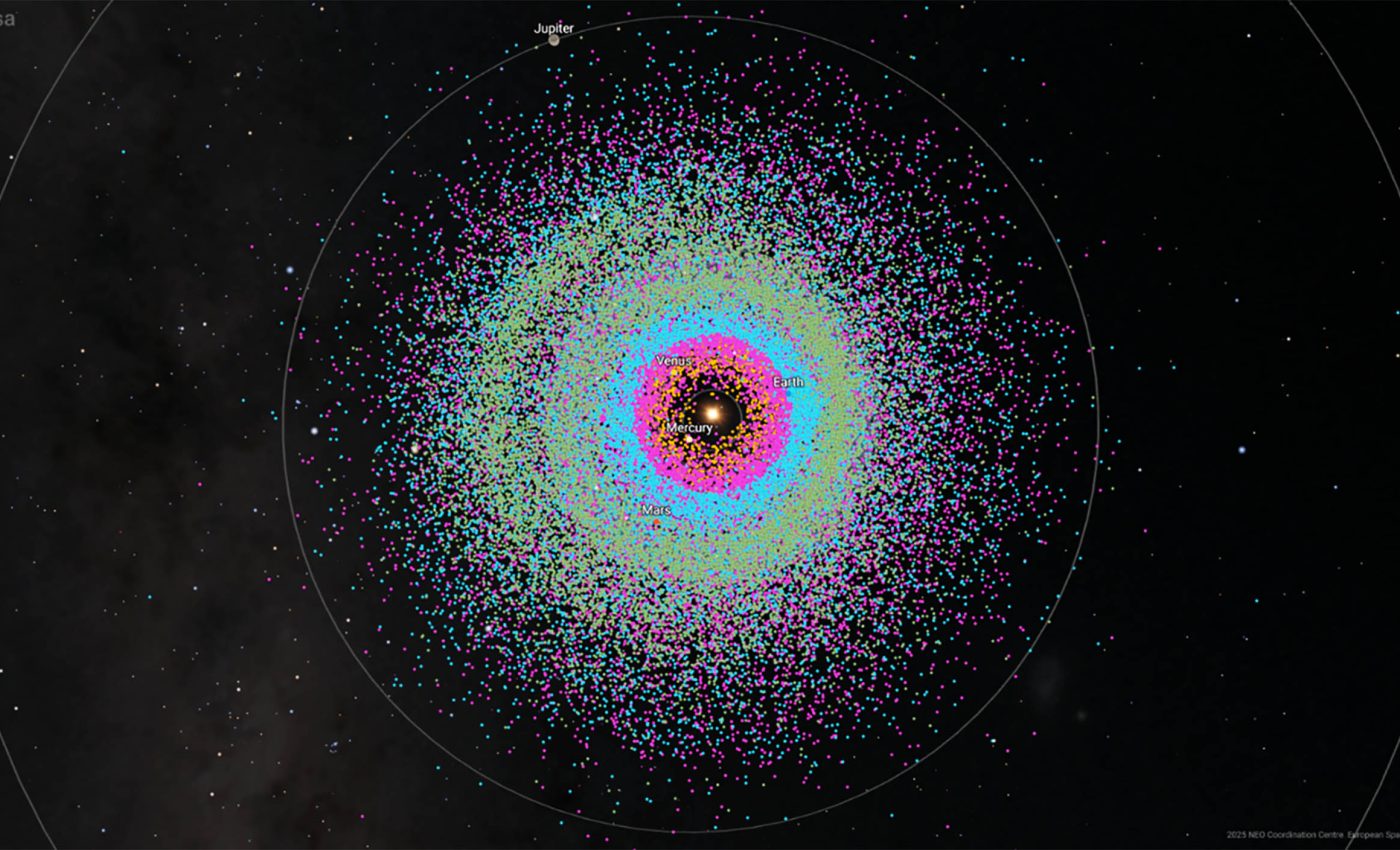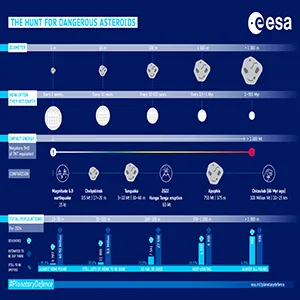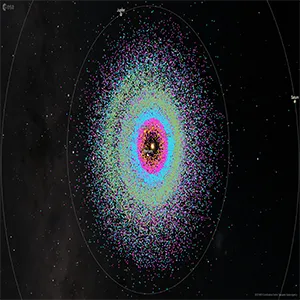
Astronomers confirm 40,000 near-Earth asteroids within striking distance
Astronomers have just logged the 40,000th near-Earth asteroid, a major marker in humanity’s effort to keep track of the rocks that pass close to our planet.
These objects range from a few yards across to a couple of miles wide. Every new one that goes into the books adds to both our knowledge and our safety.
An asteroid is basically a chunk of rock that has been around since the Solar System first took shape, more than four billion years ago.
Most of these objects circle the Sun in a broad zone between Mars and Jupiter, known as the asteroid belt.
A smaller group drifts onto routes that swing within about 28 million miles of Earth’s orbit. Those are known as near-Earth asteroids, or NEAs.
What are near-Earth asteroids?
NEAs are not all giant “planet killers.” Many are only a few yards across, and some stretch for miles, but size isn’t the whole story.
Scientists still keep tabs on these small ones. Even they can cause serious trouble if they hit a populated area. Something only a few hundred feet wide could level a city.
To avoid any surprises, astronomers study each object’s path and how forces like sunlight and gravity slowly push it around. With that information, they can figure out where an asteroid is headed years, and even centuries, from now.
Software then checks whether any of those paths come close enough to give even a tiny chance of an impact with Earth, within the next hundred years.
How asteroid hunting began
Interest in finding near-Earth asteroids began as far back as 1898. This is the year in which the very first one was recorded – Eros.
Through much of the 20th century, discoveries were infrequent since the available telescopes could scan only small sections of the sky.
Things picked up in the 1990s and 2000s. New survey telescopes began covering huge areas each night, and the number of finds shot up. Suddenly, hundreds of new NEAs were being logged every year.
“The number of discoveries is rising exponentially, from one thousand at the beginning of the century to 15 000 in 2016 and 30 000 in 2022, said Luca Conversi, manager of ESA’s Near-Earth Object Coordination Centre.
“As the next generation of telescopes enter operation, we expect the number of known NEAs to continue to grow at an even higher pace,” he added.
In November 2025, the total number of identified NEAs passed this 40,000 mark, with around 10,000 of them found in just the last three years.
Teams are watching the sky
The Near-Earth Object Coordination Centre (NEOCC), which is part of the European Space Agency’s Planetary Defence Office, sits at the heart of Europe’s effort to understand the risk from NEAs.
When a new object appears in telescope images, the center pulls together all available observations and updates predictions of its future path. Each new data point sharpens the forecast.
Almost 2,000 NEAs have a non-zero chance of impacting Earth sometime in the next hundred years. Most of these are very small and pose no significant danger. In addition, heir impact probabilities are typically much lower than one percent.
The largest NEAs, more than about two-thirds of a mile (1 kilometer) across, were easier to spot and many of them were among the first to be found.
Today the main focus is on mid-sized asteroids between about 330 and 980 feet (100 and 300 meters) wide.
These are hard to detect but would cause serious regional damage if they hit. Current models suggest that only about 30 percent of them have been discovered.
New telescopes joining the hunt
“Inaugurated this year, the Vera C. Rubin Observatory in Chile, while not dedicated exclusively to asteroid surveys, will discover tens of thousands of new NEAs and other asteroids,” stated Conversi.
The Vera C. Rubin Observatory will scan the whole visible sky every few nights, giving astronomers repeated looks at faint moving objects.
ESA’s Flyeye telescopes will bring additional resources. They break the field of view into many smaller “eyes,” allowing each system to cover a broad stretch of sky in one shot.
That design helps spot fast-moving rocks that might streak across the sky between traditional survey images.
Together, these instruments are expected to raise discovery rates even further and help close gaps in current coverage.

Near-Earth asteroid deflection
Finding dangerous rocks is only half of planetary defense. The other half is figuring out how to nudge one away if it is ever on a true collision course.
ESA’s Hera mission is now in space and en route to the asteroid Dimorphos to study the aftermath of the impact performed by NASA’s DART spacecraft in 2022.
Hera will study in detail how the DART impact altered Dimorphos’ structure and trajectory. This will help transform asteroid deflection into a reliable way of protecting Earth.
ESA is also planning the Ramses mission (Rapid Apophis Mission for Space Safety). Its aim is to rendezvous with the asteroid Apophis, which is a quarter of a mile (375 meters) in diameter.
Ramses will join Apophis on a safe but unusually close flyby of Earth in 2029, which will give scientists a near look at how such a pass influences an asteroid’s surface and motion.

Closing the blind spots
Some of the scariest impact risks come from asteroids that arrive from the direction of the Sun.
In that glare, ground-based optical telescopes on Earth’s dayside hemisphere cannot see them at all. That is one reason the Chelyabinsk event in 2013, when a small asteroid exploded over Russia, came with no warning.
Hunting asteroids in infrared light, ESA’s NEOMIR (Near-Earth Object Mission in the Infra-Red) is designed to spot these objects from space.
Targeted for launch in the mid-2030s, NEOMIR will orbit between Earth and the Sun and watch for the heat signatures of incoming rocks.
This telescope will close a large blind spot and give advance warning of impact hazards similar to the Chelyabinsk event for the first time.
What this means for life on Earth
Thankfully, none of the known near-Earth asteroids are cause for concern for the foreseeable future.
The growing catalog, along with missions like Hera, Ramses, and NEOMIR, shows that planetary defense has become a serious, organized effort.
What began with the discovery of Eros in 1898 has grown into a global project. Tens of thousands of near-Earth asteroids have now been identified.
Each new addition improves our understanding of the Solar System’s history and strengthens our ability to keep our planet safe.
This article includes information from a press release by the European Space Agency.
—–
Like what you read? Subscribe to our newsletter for engaging articles, exclusive content, and the latest updates.
Check us out on EarthSnap, a free app brought to you by Eric Ralls and Earth.com.
—–













